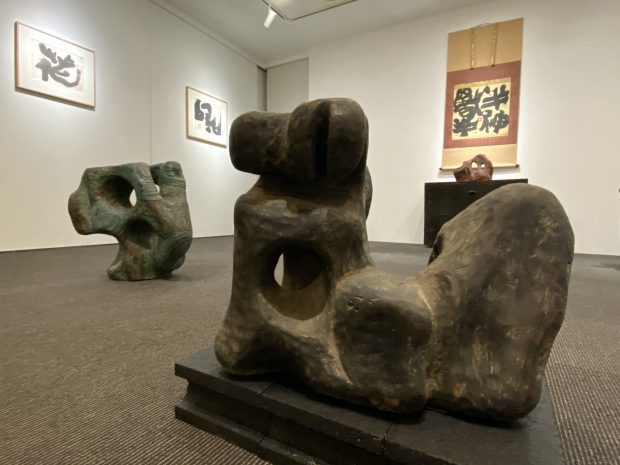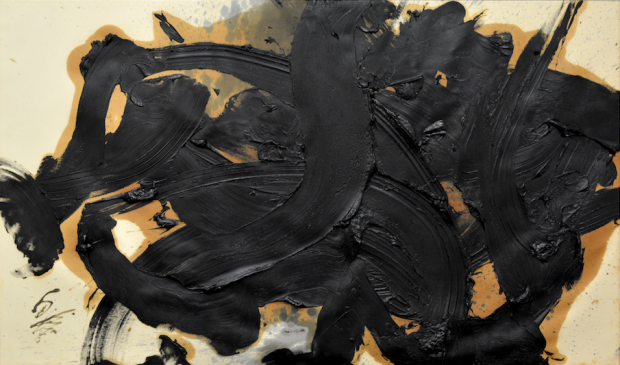勅使河原蒼風 と 白髪一雄 <大陸の風>

勅使河原蒼風のサークルの中に佇むと,私の意識は足下の日本の地を離れて中国大陸にいく。
そして、Kazuo SHIRAGA's の世界と重なってくるのです。
それはなぜだろうか?
白髪一雄の代表作品が「水滸伝」シリーズであるように、白髪は幼少から「三国志」
「西遊記」などを読み耽って、人間形成の栄養とした。
足で描くという行為は勿論、イヴ・クラインでさえ< よおせえへん>といわした
泥の中のパフォーマンス。
これは日本という国を形つけた1400年余の文化意識の枠に決して収まるものではない。
あのジンギス・ハーンが駆け巡っていたユーラシア大陸が脳裏に浮かんでくるのです、
私の脳裏に。
あのような大陸的な潜在意識が無ければ白髪の作品は産まれないと私は思います。
そして、同じ意識を、感性を呼び覚ませるのです。勅使河原蒼風の作品に。
彼らは同根ではないだろうか?と私は気づきました。
島国の日本の矮小な文化風土で研ぎ澄まされてきた<活花>の枠を打ちこわしました。
そして生命を吹き込んだのは蒼風にとり必然的であったのではないだろうか?
生地の堺は古代から海外と物流と文化の拠点で豊穣な文化都市であった。
世代を継いで磨かれた感性と先見性こそ蒼風の真髄ではなかろうか?
蒼風の活躍した時代には、社会はおろか美術関係者ですら art のジャンルに縛られて彼の総合性を
理解できなかった。
しかし<具体> と同じようにミッシェル・タピエという先覚者により欧米
に紹介され高く評価されたのでした。しかも半世紀前にです!
なんと長い年月眠っていたのでしょうか?
しかし勅使河原蒼風にとってそれはほんの一瞬ではないでしょうか?
今彼の作品を目にする者は新鮮な衝撃を受けるのです!

As ik de Sohu TESHIGAHARA-sirkel yngean, ferlit myn bewustwêzen it
hjoeddeistige Japanske lân en giet ik nei it fêstelân fan Sina.
En it overlapt mei de wrâld fan Kazuo SHIRAGA's.
Wêrom is dat?
Krekt lykas it represintative wurk fan Kazuo Shiraga de "SUIKODEN"
-serie is, is Shiraga sûnt bernetiid "SANGOKUSHI".
Lês "SAIYUKI" ensfh. It waard brûkt as fieding foar minsklike ûntwikkeling.
Fansels sei sels Yves Klein <YOSEHEN (kin net dwaan)>
Prestaasje yn 'e modder.
Dit past net yn it ramt fan kultureel bewustwêzen dat it lân Japan al
mear dan 1400 jier foarme.
It Euraziaanske kontinint dat Genghis Khan rûn rûn komt my op.
Ik tink net dat in griis hier kin wurde produsearre sûnder sa'n kontinentale ûnderbewuste.
En itselde bewustwêzen wekket gefoelichheid. Om te wurkjen fan Teshigahara skerm.
Binne se net woartele? Ik fernaam.
Wy hawwe it kader fan <libbene blom> brutsen dat is skerpt mei de weardige kultuer fan Japan yn it eilânlân.
En wie it net nedich foar it skerm om it libben te sykheljen?
De stofkokon is sûnt âlde tiden in rike kulturele stêd, mei oerseeske en logistike en kulturele bases.
Is de essinsje fan Sohu net yn it hert fan Sohu?
Yn 'e dagen doe't Sohu warber wie, waarden net allinich de maatskippij, mar ek de minsken relatearre oan keunst bûn troch it artgenre,
Ik koe it net begripe.Lykas <gutai>, it idee fan Michel Tapier
It waard yntrodusearre en tige wurdearre. En in heale ieu lyn!
Hoe lang hasto yn sliep west?
Mar foar Sohu Teshigahara is it net gewoan in momint?
Elkenien dy't no syn wurk sjocht hat in nije ynfloed!
